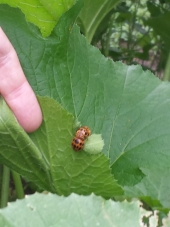




Help support my homestead by checking out the "Health and Garden/ The Essential Herbal Magazine" on our blog: www.MissouriHerbs.com








David Miller wrote:I always leave at least an equal amount of uncleared (or as my grand-mother would call it "scrub") next to my gardens because of my desire for friendlies to overwinter. I have the luxury of not being able to expand my labors/land further at the moment and the area has nice natives to nurture the good guys.
Help support my homestead by checking out the "Health and Garden/ The Essential Herbal Magazine" on our blog: www.MissouriHerbs.com








David Miller wrote:That's a great adaption, my native area isn't cultivated and has nice small tree cover so I don't have to fight the grasses. I occasionally mow a path but no cultivation. Within my cultivated area I always plant 1/4 of the land in cover crops from Spring and allow them to overwinter. I feel like this achieves the goal of the thread while also resting the land, fixing nitrogen, mulching fodder for that land which replaces lost organic material used during cultivation etc.
Help support my homestead by checking out the "Health and Garden/ The Essential Herbal Magazine" on our blog: www.MissouriHerbs.com




Brenda
Bloom where you are planted.
http://restfultrailsfoodforestgarden.blogspot.com/








Brenda Groth wrote:i generally go thru with a bucket and take about 1/2 of the good ripe seeds and seedheads to replant IF I need the new plants..and leave everything else stanidng all winter. I wait until I have to to remove any of the standing stuff..honestly ..in most areas I leave it all all the time..year around..as it falls down and makes a great mulch..and feeds the soil.
If it is really invasive (like my mallows) I remove a lot of them, but I don't burn them ..I stack piles of them at the edges of the woods..so they still can be used by critters.
I do remove most of the leaves from the lawnish areas..and put them in the gardenish areas also so they'll rot and feed the soil but not ruin the lawnish spots (sometimes I've missed and completely killed off the grass in those areas..what a mess).
comfrey is esp useful for overwintering beneficials so leave as much of it as you can..also cane plants...as they hollow cores are great for some bees to live in
Help support my homestead by checking out the "Health and Garden/ The Essential Herbal Magazine" on our blog: www.MissouriHerbs.com

|
Whoever got anywhere by being normal? Just ask this exceptional tiny ad:
Freaky Cheap Heat - 2 hour movie - HD streaming
https://permies.com/wiki/238453/Freaky-Cheap-Heat-hour-movie
|





